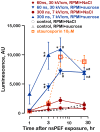Two modes of cell death caused by exposure to nanosecond pulsed electric field
- PMID: 23894630
- PMCID: PMC3720895
- DOI: 10.1371/journal.pone.0070278
Two modes of cell death caused by exposure to nanosecond pulsed electric field
Abstract
High-amplitude electric pulses of nanosecond duration, also known as nanosecond pulsed electric field (nsPEF), are a novel modality with promising applications for cell stimulation and tissue ablation. However, key mechanisms responsible for the cytotoxicity of nsPEF have not been established. We show that the principal cause of cell death induced by 60- or 300-ns pulses in U937 cells is the loss of the plasma membrane integrity ("nanoelectroporation"), leading to water uptake, cell swelling, and eventual membrane rupture. Most of this early necrotic death occurs within 1-2 hr after nsPEF exposure. The uptake of water is driven by the presence of pore-impermeable solutes inside the cell, and can be counterbalanced by the presence of a pore-impermeable solute such as sucrose in the medium. Sucrose blocks swelling and prevents the early necrotic death; however the long-term cell survival (24 and 48 hr) does not significantly change. Cells protected with sucrose demonstrate higher incidence of the delayed death (6-24 hr post nsPEF). These cells are more often positive for the uptake of an early apoptotic marker dye YO-PRO-1 while remaining impermeable to propidium iodide. Instead of swelling, these cells often develop apoptotic fragmentation of the cytoplasm. Caspase 3/7 activity increases already in 1 hr after nsPEF and poly-ADP ribose polymerase (PARP) cleavage is detected in 2 hr. Staurosporin-treated positive control cells develop these apoptotic signs only in 3 and 4 hr, respectively. We conclude that nsPEF exposure triggers both necrotic and apoptotic pathways. The early necrotic death prevails under standard cell culture conditions, but cells rescued from the necrosis nonetheless die later on by apoptosis. The balance between the two modes of cell death can be controlled by enabling or blocking cell swelling.
Conflict of interest statement
Figures









Similar articles
-
Nanosecond pulsed electric fields induce poly(ADP-ribose) formation and non-apoptotic cell death in HeLa S3 cells.Biochem Biophys Res Commun. 2013 Aug 30;438(3):557-62. doi: 10.1016/j.bbrc.2013.07.083. Epub 2013 Jul 27. Biochem Biophys Res Commun. 2013. PMID: 23899527
-
Calcium-mediated pore expansion and cell death following nanoelectroporation.Biochim Biophys Acta. 2014 Oct;1838(10):2547-54. doi: 10.1016/j.bbamem.2014.06.015. Epub 2014 Jun 28. Biochim Biophys Acta. 2014. PMID: 24978108 Free PMC article.
-
The cytotoxic synergy of nanosecond electric pulses and low temperature leads to apoptosis.Sci Rep. 2016 Nov 11;6:36835. doi: 10.1038/srep36835. Sci Rep. 2016. PMID: 27833151 Free PMC article.
-
Neuronal trauma model: in search of Thanatos.Int J Dev Neurosci. 2004 Nov;22(7):485-96. doi: 10.1016/j.ijdevneu.2004.07.015. Int J Dev Neurosci. 2004. PMID: 15465278 Review.
-
Immune response triggered by the ablation of hepatocellular carcinoma with nanosecond pulsed electric field.Front Med. 2021 Apr;15(2):170-177. doi: 10.1007/s11684-020-0747-z. Epub 2020 Nov 13. Front Med. 2021. PMID: 33185811 Review.
Cited by
-
Rapid and precise tracking of water influx and efflux across cell membranes induced by a pulsed electric field.Biomed Opt Express. 2023 Apr 4;14(5):1894-1910. doi: 10.1364/BOE.485627. eCollection 2023 May 1. Biomed Opt Express. 2023. PMID: 37206120 Free PMC article.
-
Calcium-independent disruption of microtubule dynamics by nanosecond pulsed electric fields in U87 human glioblastoma cells.Sci Rep. 2017 Jan 24;7:41267. doi: 10.1038/srep41267. Sci Rep. 2017. PMID: 28117459 Free PMC article.
-
Calcium-dependent activation of transglutaminase 2 by nanosecond pulsed electric fields.FEBS Open Bio. 2017 Jun 9;7(7):934-943. doi: 10.1002/2211-5463.12227. eCollection 2017 Jul. FEBS Open Bio. 2017. PMID: 28680807 Free PMC article.
-
Enhanced Cellular Doxorubicin Uptake via Delayed Exposure Following Nanosecond Pulsed Electric Field Treatment: An In Vitro Study.Pharmaceutics. 2024 Jun 24;16(7):851. doi: 10.3390/pharmaceutics16070851. Pharmaceutics. 2024. PMID: 39065548 Free PMC article.
-
Nanosecond Pulsed Electric Fields Induce Endoplasmic Reticulum Stress Accompanied by Immunogenic Cell Death in Murine Models of Lymphoma and Colorectal Cancer.Cancers (Basel). 2019 Dec 17;11(12):2034. doi: 10.3390/cancers11122034. Cancers (Basel). 2019. PMID: 31861079 Free PMC article.
References
-
- Schoenbach KS, Hargrave B, Joshi RP, Kolb J, Osgood C, et al. (2007) Bioelectric Effects of Nanosecond Pulses. IEEE Transactions on Dielectrics and Electrical Insulation 14: 1088–1109.
-
- Ren W, Sain NM, Beebe SJ (2012) Nanosecond pulsed electric fields (nsPEFs) activate intrinsic caspase-dependent and caspase-independent cell death in Jurkat cells. Biochemical and biophysical research communications 421: 808–812. - PubMed
-
- Beebe SJ, Fox PM, Rec LJ, Somers K, Stark RH, et al. (2002) Nanosecond Pulsed Electric Field (nsPEF) Effects on Cells and Tissues: Apoptosis Induction and Tumor Growth Inhibition. IEEE Transactions on Plasma Science 30: 286–292.
-
- Garon EB, Sawcer D, Vernier PT, Tang T, Sun Y, et al. (2007) In vitro and in vivo evaluation and a case report of intense nanosecond pulsed electric field as a local therapy for human malignancies. Int J Cancer 121: 675–682. - PubMed
Publication types
MeSH terms
Substances
Grants and funding
LinkOut - more resources
Full Text Sources
Other Literature Sources
Research Materials
Miscellaneous

